Ask Our Experts: Navigating the complexities of drug development with integrated platforms
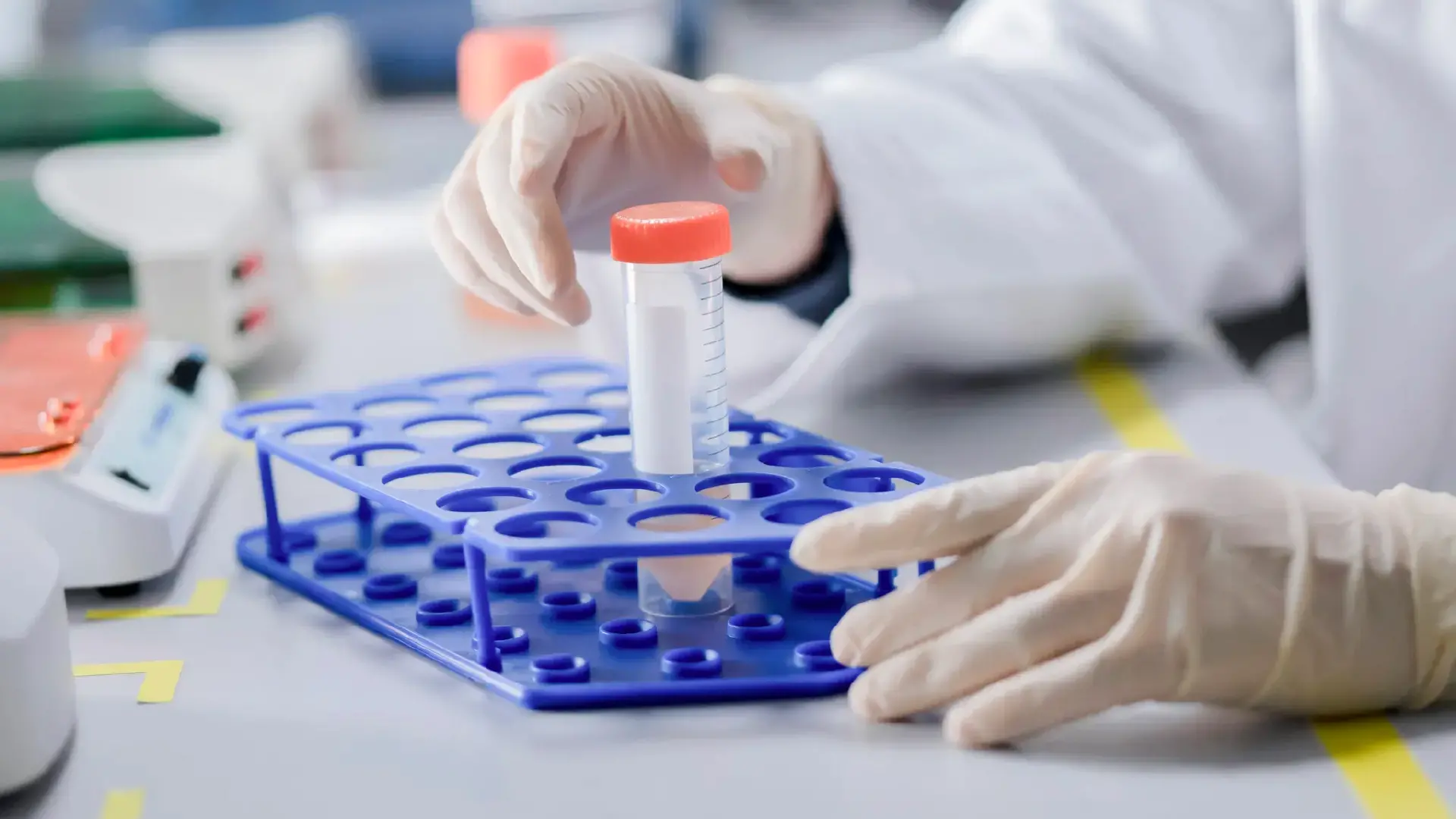

Strategic decisions made in the early development phase shape the entire course of a biologic’s journey. A molecule with unfavorable characteristics or an underperforming cell line can impact productivity, costs, and timelines. To help clients navigate these complexities, Samsung Biologics offers a comprehensive suite of platforms—DEVELOPICK™, S-AfuCHO™, S-HiCon™—as well as analytical methods designed to de-risk early development and accelerate progress toward IND and beyond.
This Q&A article is based on questions submitted by attendees during our recent webinars on development services. Gain insights on how Samsung Biologics utilizes advanced platforms to support smarter and faster development, backed by robust data and predictive tools.
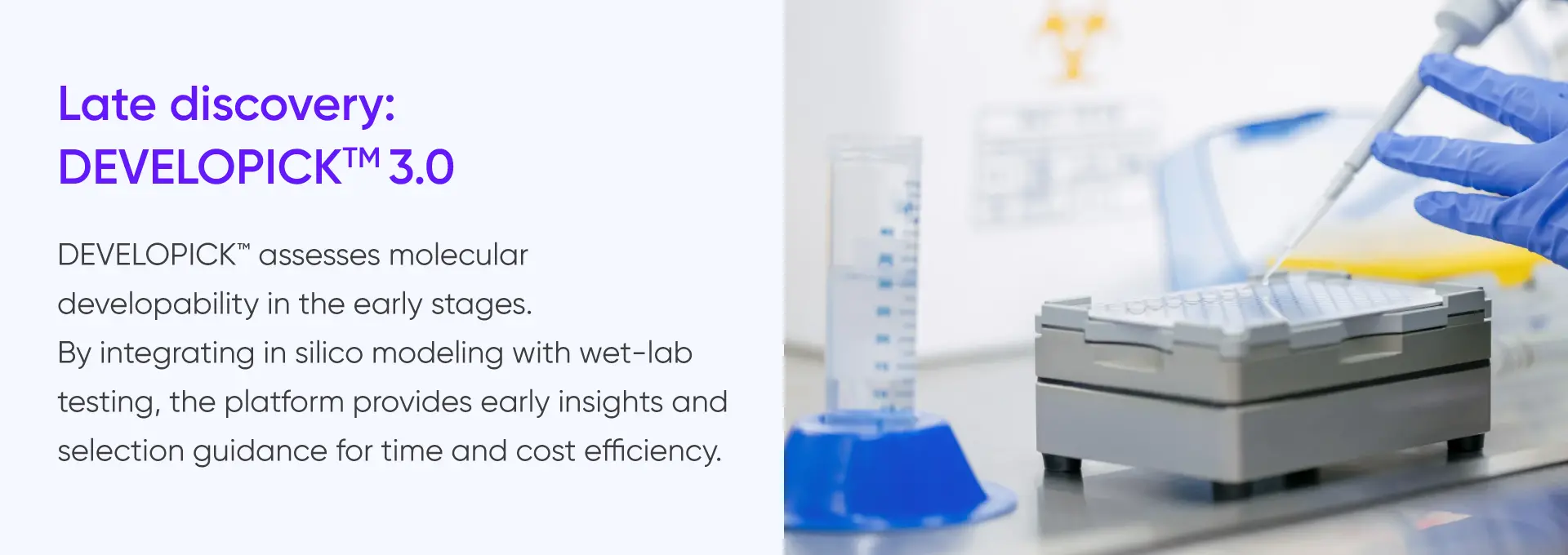
Q1. How does DEVELOPICK™ contribute to regulatory readiness?
DEVELOPICK™ is designed to identify potential risks in candidate molecules during the late discovery stage. While DEVELOPICK™ data are not submitted directly to regulatory agencies, the insights guide key decisions in process design and formulation. By identifying key molecular liabilities—such as pH sensitivity, aggregation, or instability—DEVELOPICK™ provides early insights and selection guidance to improve decision-making.
In one case, a molecule was found to be highly unstable at low pH. This finding, flagged through DEVELOPICK™, allowed Samsung Biologics’ downstream process team to implement an alternative virus inactivation method. Early risk identification helped the client not only avoid potential degradation issues but also meet the initial development timeline and budget, leading to clinical progression without delay.
Q2. How are key molecular characteristics assessed in the late discovery stage?
We integrate both in silico and experimental analytical capabilities to determine interrelated properties like stability and solubility. Sequence liabilities—such as aggregation, deamidation, and oxidation—are predicted using proprietary algorithms. These findings are complemented by experimental testing, including DSF*, DLS*, SE-HPLC*, icIEF*, and solubility/hydrophobicity assays using small sample quantities. The results are benchmarked against a comprehensive internal database, providing a comparative framework that supports decision-making for manufacturability and downstream development feasibility.
* DSF: Differential scanning Fluorimetry
* DLS: Dynamic Light Scattering
* SE-HPLC: Size Exclusion-High Performance Liquid Chromatography
* icIEF: imaged capillary isoelectric focusing
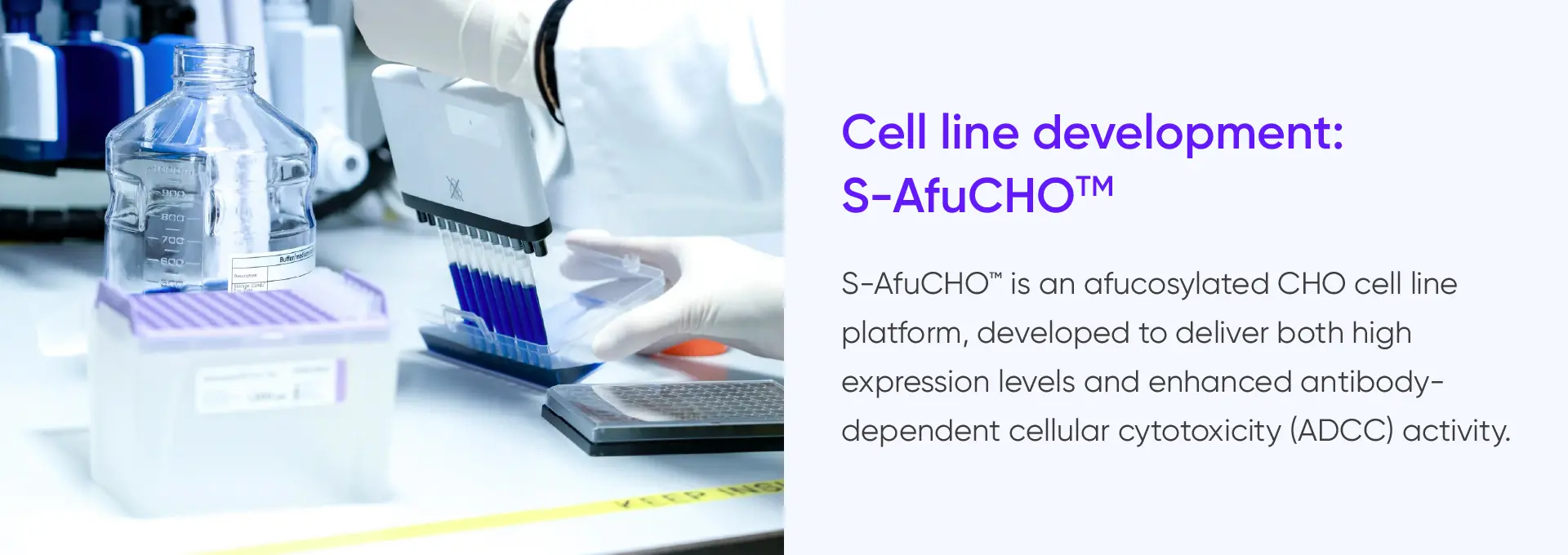
Q1. What are the differences between transposase systems and CRISPR/Cas9 for stable integration?
The transposase system enables efficient and multi-copy integration of the gene of interest into transcriptionally active regions of the genome. Depending on the type of transposase, one can expect 5 to over 20 intact copies to be inserted, allowing for robust expression levels suitable for multi-gram-per-liter production. CRISPR/Cas9-based targeted integration is much more site-specific, generally supporting fewer copies that lead to lower overall expression levels. However, it enables predictable integration with characterized clone performance and stability. Each method has its own strategic advantages depending on the project goals.
Q2. What performance characteristics have been observed with
S-AfuCHO™?
S-AfuCHO™ has achieved titers >5 g/L for mAbs with stable expression confirmed over 60 population doublings. Importantly, the platform consistently produces antibodies with >99% afucosylation, which enhances ADCC. Internal cell-based assays have shown that molecules produced using S-AfuCHO™ can exhibit up to 10-fold higher ADCC activity compared to that of conventional platforms.
Q3. How are integration sites selected?
We have evaluated S-AfuCHO™ with the transposase system to utilize a TTAA sequence recognition pattern, allowing the transposon to integrate into suitable regions across the genome. These insertion points are selected to maximize transcriptional activity and ensure high-level, stable expression. Compared to its predecessor, S-CHOice™ and S-AfuCHO™ can maintain robust cell growth, productivity, and clone stability while maximizing afucosylation for the desired Fc-mediated ADCC response.

Q1. How do you manage challenges such as the Donnan effect in high-concentration formulations?
The Donnan and volume-exclusion effects can cause pH shifts during ultrafiltration and diafiltration (UF/DF) when developing high-concentration formulations. Samsung Biologics addresses this by characterizing potential shifts early in the development process and adjusting the diafiltration buffer accordingly to maintain the desired pH range in the final formulation. This helps preserve protein integrity and manufacturing consistency.
Q2. What is your approach to excipient and surfactant screening?
Our formulation strategy begins with surfactant type screening, followed by pH and buffer selection studies, and then a final screening study for excipient selection. This workflow allows Samsung Biologics to conduct formulation development in a structured and data-driven manner. The process can be tailored to specific molecule attributes and client needs to ensure workflow flexibility.
Q3. Why is it important to evaluate both physical and chemical stability during formulation?
High-concentration formulations are particularly prone to issues such as aggregation and sub-visible particle formation. While physical stability issues are often a major focus for high-concentration formulations, chemical stability issues—encompassing degradation pathways like oxidation and deamidation—are equally important. A successful formulation must achieve a balance between these two aspects to ensure product quality and safety.
Q4. Are specialized excipients needed for high-concentration biologics?
Yes. Formulations often require different types of excipients, such as viscosity modifiers or solubility enhancers, to improve manufacturability and ensure stable drug product profiles. These are evaluated during screening studies to determine their impact on critical quality attributes, allowing for more robust formulation.
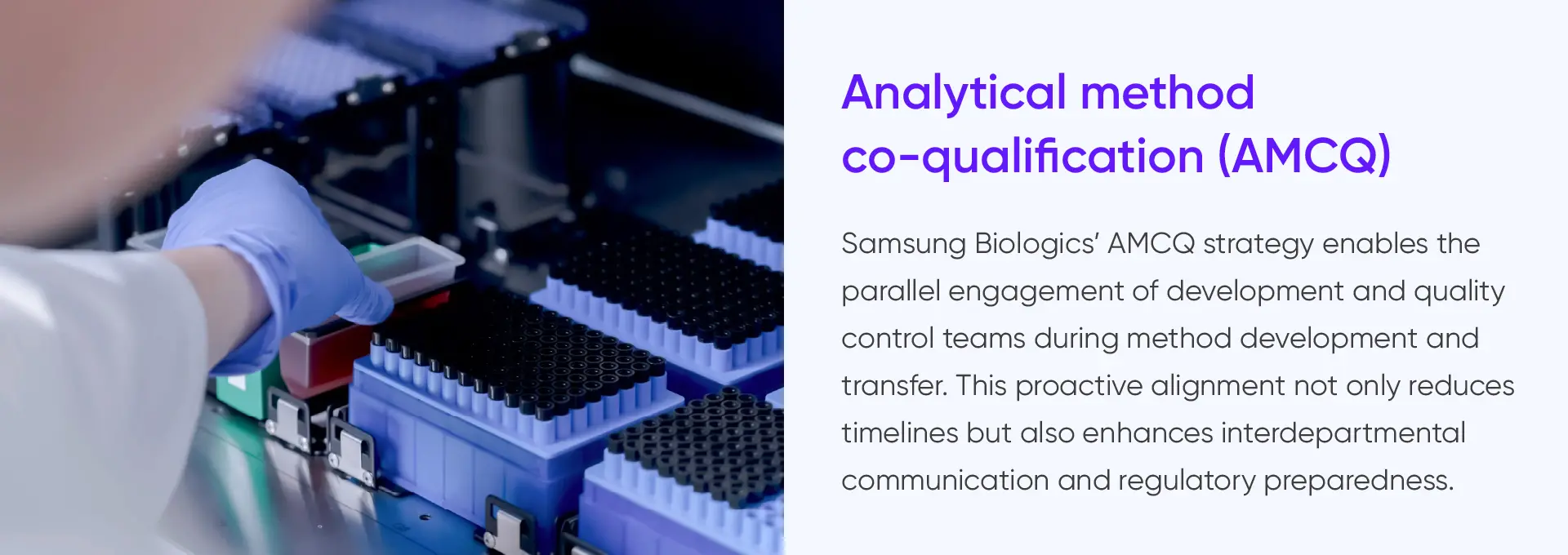
Q1. What are the key requirements for successful analytical method co-qualification?
Effective AMCQ requires cross-functional coordination among quality assurance (QA), quality control (QC), and development teams. Key factors include trained and validated equipment, secure data handling, aligned documentation procedures, and consistent material supply. Performing a quality risk assessment in the beginning helps identify and mitigate any gaps between development and QC operations.
Q2. How does AMCQ maintain analytical quality standards?
AMCQ strategies are structured to comply with ICH* Validation of Analytical Procedures Q2(R2). Under this model, the development team leads method optimization, while QC executes verification and qualification in parallel. Through the preemptive alignment of both teams, the approach ensures methodological consistency and minimizes the risk of discrepancies during GMP batch release.
* The International Council for Harmonisation of Technical Requirements for Pharmaceuticals for Human Use
Q3. What impact does AMCQ have on development timelines and scalability?
The co-qualification model has been shown to reduce
timelines from development to method transfer by approximately three months. Previously, Samsung
Biologics’ development and quality teams would sequentially develop, transfer, and qualify methods over
7.5 months. AMCQ can reduce method transfer timelines by ~3 months from 7.5 to 4.5 months. While AMCQ itself
does not affect scalability, it improves operational efficiency during tech transfer. Differences in analytical
data observed at larger scales are generally attributable to material variability rather than AMCQ
activities.
Q4. What are the main risks and how are they addressed?
Risks arise primarily when different materials are used between development, transfer, and GMP manufacturing stages. To address this, Samsung Biologics recommends using GMP-applicable or process-representative materials whenever possible. Special attention is given to charge-related methods, where variations in folding status or potency could lead to analytical inconsistencies. Clear communication and process alignment help prevent such issues.
Q5. What are the advantages of adopting AMCQ?
Beyond timeline reduction, AMCQ minimizes gaps between department operations, improves tech transfer accuracy, and supports readiness for GMP batch testing. This integrated approach enhances overall project agility while maintaining the highest standards of analytical quality and compliance.
Samsung Biologics’ integrated development platforms are designed to support every stage of the biologics development journey—from early developability assessments and high-performance cell lines to formulation design and analytical method readiness. By combining technical depth with cross-functional alignment, these platforms help biopharma clients advance with greater speed, confidence, and quality.
To learn more about how Samsung Biologics can support your molecule from discovery to IND and beyond, contact us or visit our website: https://samsungbiologics.com/services/biopharma-development


Strategic decisions made in the early development phase shape the entire course of a biologic’s journey. A molecule with unfavorable characteristics or an underperforming cell line can impact productivity, costs, and timelines. To help clients navigate these complexities, Samsung Biologics offers a comprehensive suite of platforms—DEVELOPICK™, S-AfuCHO™, S-HiCon™—as well as analytical methods designed to de-risk early development and accelerate progress toward IND and beyond.
This Q&A article is based on questions submitted by attendees during our recent webinars on development services. Gain insights on how Samsung Biologics utilizes advanced platforms to support smarter and faster development, backed by robust data and predictive tools.
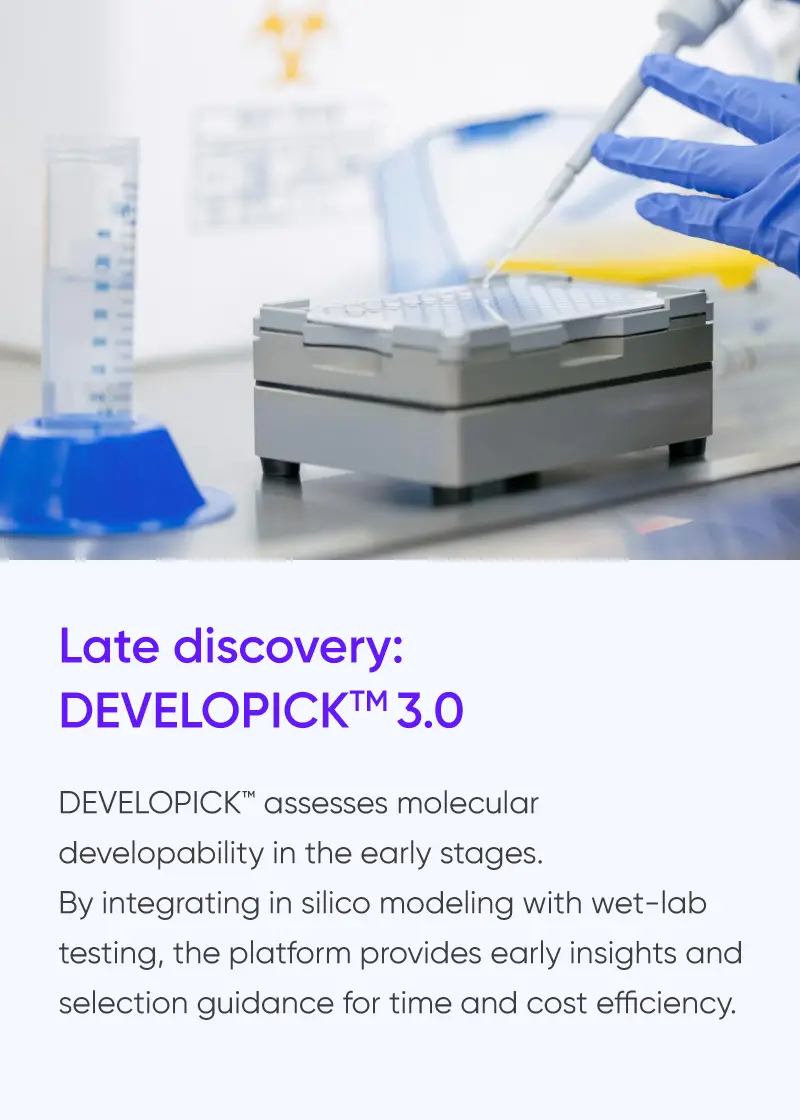
Q1. How does DEVELOPICK™ contribute to regulatory readiness?
DEVELOPICK™ is designed to identify potential risks in candidate molecules during the late discovery stage. While DEVELOPICK™ data are not submitted directly to regulatory agencies, the insights guide key decisions in process design and formulation. By identifying key molecular liabilities—such as pH sensitivity, aggregation, or instability—DEVELOPICK™ provides early insights and selection guidance to improve decision-making.
In one case, a molecule was found to be highly unstable at low pH. This finding, flagged through DEVELOPICK™, allowed Samsung Biologics’ downstream process team to implement an alternative virus inactivation method. Early risk identification helped the client not only avoid potential degradation issues but also meet the initial development timeline and budget, leading to clinical progression without delay.
Q2. How are key molecular characteristics assessed in the late discovery stage?
We integrate both in silico and experimental analytical capabilities to determine interrelated properties like stability and solubility. Sequence liabilities—such as aggregation, deamidation, and oxidation—are predicted using proprietary algorithms. These findings are complemented by experimental testing, including DSF*, DLS*, SE-HPLC*, icIEF*, and solubility/hydrophobicity assays using small sample quantities. The results are benchmarked against a comprehensive internal database, providing a comparative framework that supports decision-making for manufacturability and downstream development feasibility.
* DSF: Differential scanning Fluorimetry
* DLS: Dynamic Light Scattering
* SE-HPLC: Size Exclusion-High Performance Liquid Chromatography
* icIEF: imaged capillary isoelectric focusing
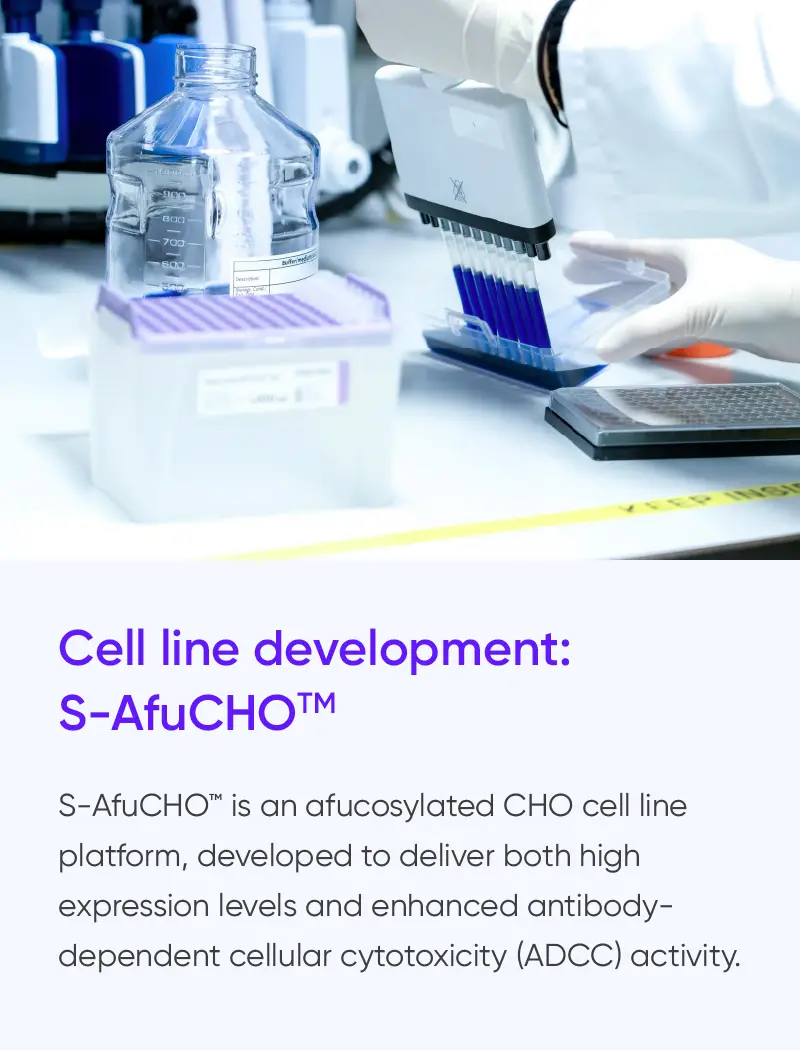
Q1. What are the differences between transposase systems and CRISPR/Cas9 for stable integration?
The transposase system enables efficient and multi-copy integration of the gene of interest into transcriptionally active regions of the genome. Depending on the type of transposase, one can expect 5 to over 20 intact copies to be inserted, allowing for robust expression levels suitable for multi-gram-per-liter production. CRISPR/Cas9-based targeted integration is much more site-specific, generally supporting fewer copies that lead to lower overall expression levels. However, it enables predictable integration with characterized clone performance and stability. Each method has its own strategic advantages depending on the project goals.
Q2. What performance characteristics have been observed with S-AfuCHO™?
S-AfuCHO™ has achieved titers >5 g/L for mAbs with stable expression confirmed over 60 population doublings. Importantly, the platform consistently produces antibodies with >99% afucosylation, which enhances ADCC. Internal cell-based assays have shown that molecules produced using S-AfuCHO™ can exhibit up to 10-fold higher ADCC activity compared to that of conventional platforms.
Q3. How are integration sites selected?
We have evaluated S-AfuCHO™ with the transposase system to utilize a TTAA sequence recognition pattern, allowing the transposon to integrate into suitable regions across the genome. These insertion points are selected to maximize transcriptional activity and ensure high-level, stable expression. Compared to its predecessor, S-CHOice™ and S-AfuCHO™ can maintain robust cell growth, productivity, and clone stability while maximizing afucosylation for the desired Fc-mediated ADCC response.
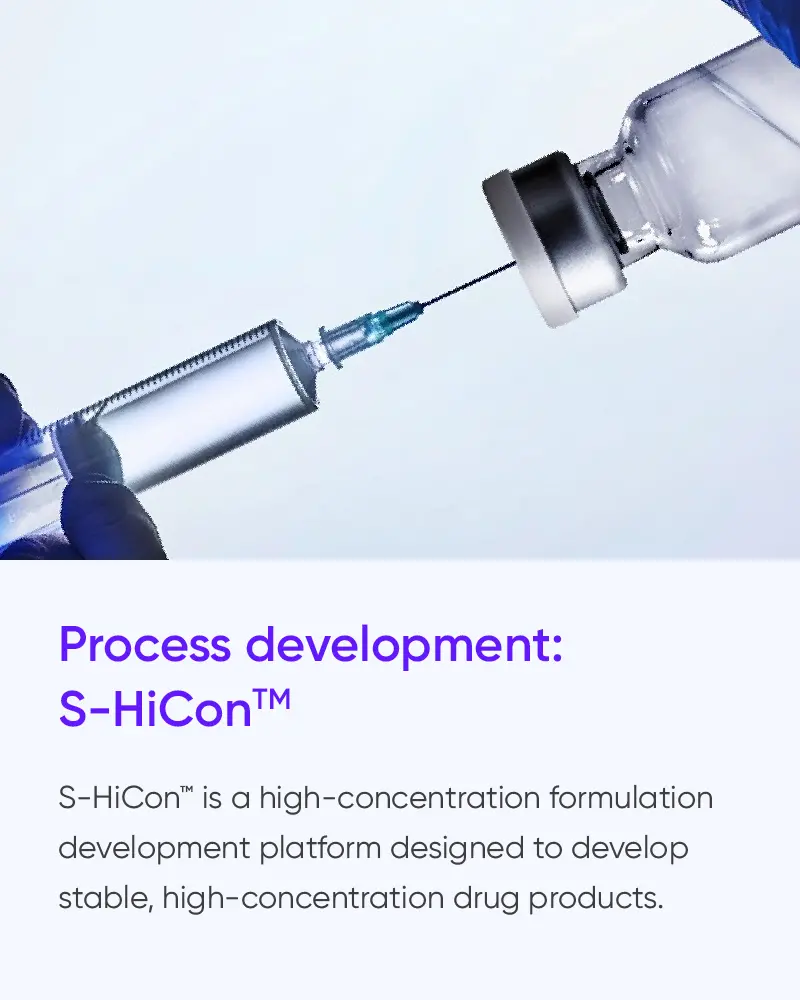
Q1. How do you manage challenges such as the Donnan effect in high-concentration formulations?
The Donnan and volume-exclusion effects can cause pH shifts during ultrafiltration and diafiltration (UF/DF) when developing high-concentration formulations. Samsung Biologics addresses this by characterizing potential shifts early in the development process and adjusting the diafiltration buffer accordingly to maintain the desired pH range in the final formulation. This helps preserve protein integrity and manufacturing consistency.
Q2. What is your approach to excipient and surfactant screening?
Our formulation strategy begins with surfactant type screening, followed by pH and buffer selection studies, and then a final screening study for excipient selection. This workflow allows Samsung Biologics to conduct formulation development in a structured and data-driven manner. The process can be tailored to specific molecule attributes and client needs to ensure workflow flexibility.
Q3. Why is it important to evaluate both physical and chemical stability during formulation?
High-concentration formulations are particularly prone to issues such as aggregation and sub-visible particle formation. While physical stability issues are often a major focus for high-concentration formulations, chemical stability issues—encompassing degradation pathways like oxidation and deamidation—are equally important. A successful formulation must achieve a balance between these two aspects to ensure product quality and safety.
Q4. Are specialized excipients needed for high-concentration biologics?
Yes. Formulations often require different types of excipients, such as viscosity modifiers or solubility enhancers, to improve manufacturability and ensure stable drug product profiles. These are evaluated during screening studies to determine their impact on critical quality attributes, allowing for more robust formulation.
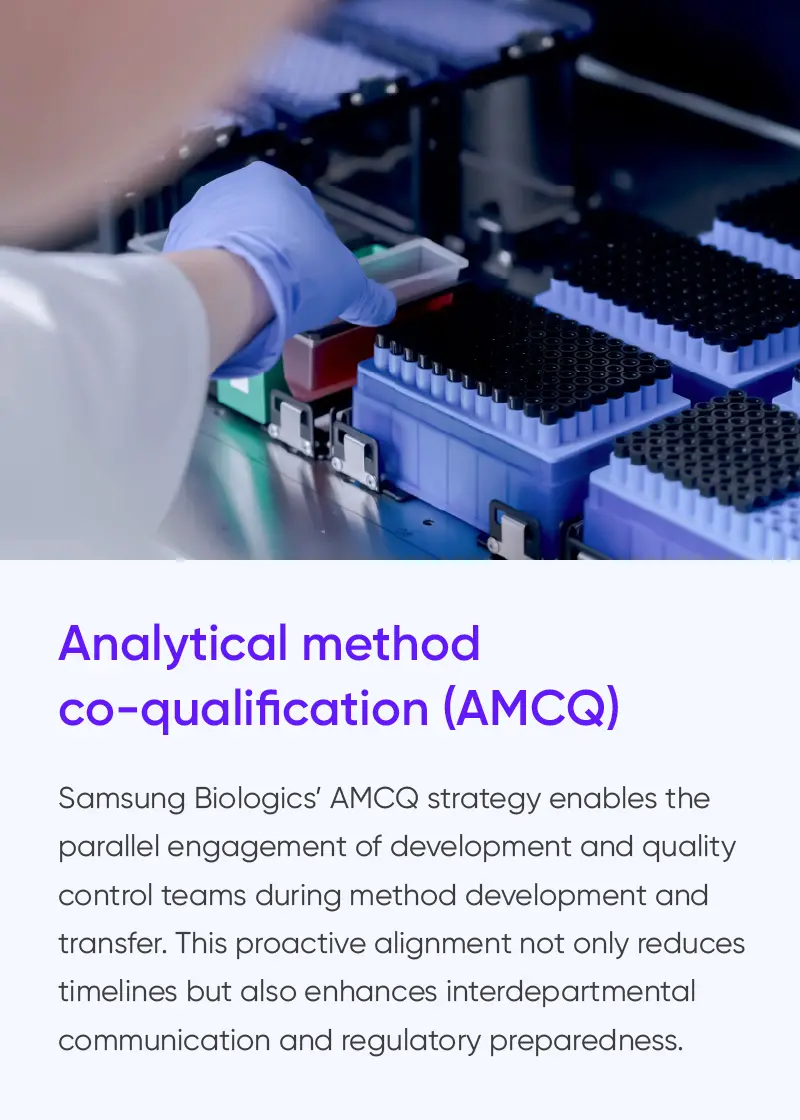
Q1. What are the key requirements for successful analytical method co-qualification?
Effective AMCQ requires cross-functional coordination among quality assurance (QA), quality control (QC), and development teams. Key factors include trained and validated equipment, secure data handling, aligned documentation procedures, and consistent material supply. Performing a quality risk assessment in the beginning helps identify and mitigate any gaps between development and QC operations.
Q2. How does AMCQ maintain analytical quality standards?
AMCQ strategies are structured to comply with ICH* Validation of Analytical Procedures Q2(R2). Under this model, the development team leads method optimization, while QC executes verification and qualification in parallel. Through the preemptive alignment of both teams, the approach ensures methodological consistency and minimizes the risk of discrepancies during GMP batch release.
* The International Council for Harmonisation of Technical Requirements for Pharmaceuticals for Human Use
Q3. What impact does AMCQ have on development timelines and scalability?
The co-qualification model has been
shown to reduce timelines from development to method transfer by approximately three months. Previously, Samsung
Biologics’ development and quality teams would sequentially develop, transfer, and qualify methods over
7.5 months. AMCQ can reduce method transfer timelines by ~3 months from 7.5 to 4.5 months. While AMCQ itself
does not affect scalability, it improves operational efficiency during tech transfer. Differences in analytical
data observed at larger scales are generally attributable to material variability rather than AMCQ
activities.
Q4. What are the main risks and how are they addressed?
Risks arise primarily when different materials are used between development, transfer, and GMP manufacturing stages. To address this, Samsung Biologics recommends using GMP-applicable or process-representative materials whenever possible. Special attention is given to charge-related methods, where variations in folding status or potency could lead to analytical inconsistencies. Clear communication and process alignment help prevent such issues.
Q5. What are the advantages of adopting AMCQ?
Beyond timeline reduction, AMCQ minimizes gaps between department operations, improves tech transfer accuracy, and supports readiness for GMP batch testing. This integrated approach enhances overall project agility while maintaining the highest standards of analytical quality and compliance.
Samsung Biologics’ integrated development platforms are designed to support every stage of the biologics development journey—from early developability assessments and high-performance cell lines to formulation design and analytical method readiness. By combining technical depth with cross-functional alignment, these platforms help biopharma clients advance with greater speed, confidence, and quality.
To learn more about how Samsung Biologics can support your molecule from discovery to IND and beyond, contact us or visit our website: https://samsungbiologics.com/services/biopharma-development
Share article
Related Content